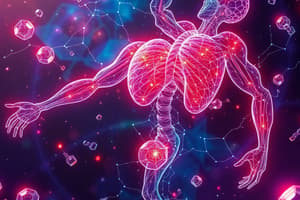Podcast
Questions and Answers
Which receptor is responsible for the effect of acetylcholine vesicles coming closer to the synapse for the next stimulus?
Which receptor is responsible for the effect of acetylcholine vesicles coming closer to the synapse for the next stimulus?
- Nonmyelinated motor nerve terminal
- Muscle-type nicotinic acetylcholine receptor
- Extrajunctional nicotinic receptor
- Nerve-type nicotinic acetylcholine receptor (correct)
In which situations do the number of extrajunctional nicotinic receptors increase rapidly?
In which situations do the number of extrajunctional nicotinic receptors increase rapidly?
- During contraction mechanisms within the cell
- During immobilization (correct)
- During muscle relaxation
- During normal muscle functioning
How can blocking the neuromuscular junction be achieved?
How can blocking the neuromuscular junction be achieved?
- Somatic pathway in CNS
- Depolarized and non-depolarized methods (correct)
- Contraction mechanisms within the cell
- Myelinated and nonmyelinated nerve cells
Which stage can create muscle paralysis by affecting the motor nerve terminal and motor end plate?
Which stage can create muscle paralysis by affecting the motor nerve terminal and motor end plate?
What is the prototype of depolarizing neuromuscular blockers?
What is the prototype of depolarizing neuromuscular blockers?
Which drug prevents acetylcholine from binding to the receptor?
Which drug prevents acetylcholine from binding to the receptor?
What is the synthetic analogue of curare?
What is the synthetic analogue of curare?
What is the effect duration of rocuronium, a nondepolarizing blocker?
What is the effect duration of rocuronium, a nondepolarizing blocker?
What is the condition called when succinylcholine continues to occupy the receptor after the first attachment?
What is the condition called when succinylcholine continues to occupy the receptor after the first attachment?
Which muscle is affected last by nondepolarizing neuromuscular blockers?
Which muscle is affected last by nondepolarizing neuromuscular blockers?
What is the effect duration of mivacurium, a nondepolarizing blocker?
What is the effect duration of mivacurium, a nondepolarizing blocker?
What is the duration of action of succinylcholine?
What is the duration of action of succinylcholine?
What is the term for the last period of Phase II of depolarizing neuromuscular blockers?
What is the term for the last period of Phase II of depolarizing neuromuscular blockers?
What must occur for the excitation-contraction coupling of the muscle to work?
What must occur for the excitation-contraction coupling of the muscle to work?
What may increase the effectiveness of depolarizing neuromuscular blockers?
What may increase the effectiveness of depolarizing neuromuscular blockers?
What is the route of administration for neuromuscular drugs due to their high polarity?
What is the route of administration for neuromuscular drugs due to their high polarity?
Flashcards are hidden until you start studying
Study Notes
Neuromuscular Junction
- Rapsyn receptor is responsible for bringing acetylcholine vesicles closer to the synapse for the next stimulus.
Nicotinic Receptors
- The number of extrajunctional nicotinic receptors increases rapidly in situations such as denervation, muscular dystrophy, and myasthenia gravis.
Blocking Neuromuscular Junction
- Blocking the neuromuscular junction can be achieved by using neuromuscular blockers.
Stages of Muscle Paralysis
- The stage that can create muscle paralysis by affecting the motor nerve terminal and motor end plate is the neuromuscular junction.
Depolarizing Neuromuscular Blockers
- Succinylcholine is the prototype of depolarizing neuromuscular blockers.
- The effect of succinylcholine is that it continues to occupy the receptor after the first attachment, a condition called phase II.
- The duration of action of succinylcholine is 3-5 minutes.
Nondepolarizing Neuromuscular Blockers
- D-tubocurarine is a synthetic analogue of curare.
- Rocuronium is a nondepolarizing blocker with an effect duration of 30-60 minutes.
- Mivacurium is a nondepolarizing blocker with an effect duration of 15-20 minutes.
- The diaphragm is affected last by nondepolarizing neuromuscular blockers.
Excitation-Contraction Coupling
- For the excitation-contraction coupling of the muscle to work, acetylcholine must bind to its receptor.
- Drugs that prevent acetylcholine from binding to its receptor, such as d-tubocurarine, can increase the effectiveness of depolarizing neuromuscular blockers.
Administration of Neuromuscular Drugs
- Neuromuscular drugs are administered intravenously due to their high polarity.
Studying That Suits You
Use AI to generate personalized quizzes and flashcards to suit your learning preferences.




